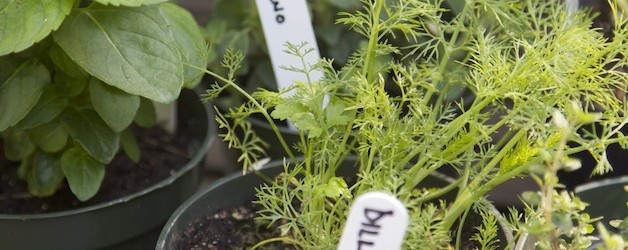

Fresh herbs are a wonderful, versatile ingredient that bring great flavor to dishes, and often, you don’t need to use much to get that flavor. In addition to brightening flavor, herbs are also a nutritional resource of vitamins and antioxidants. With summer fast approaching, it’s a good time to start a small herb pot or garden (we’ll cover this in detail next week). Fresh herbs are widely available in stores, but growing your own herbs is easy, a lot less expensive, and you always have them available for adding to a meal when you can just snip what you need from your own garden. Herbs are such a fundamental part of cooking, and allow for so much variation in dishes, that we are going to cover them in two parts: 1. An overview of fresh herbs, and 2. An introduction to growing herbs.
Our Favorite Culinary Herbs
These are the herbs we love to use in our cooking, along with a few ideas for how to use them. (Mark Bittman’s How to Cook Everything is a great resource if you need more ideas for leftover herbs, or search online by herb.)
- Basil – Usually used raw or cooked for a short time. Use in pestos, add to salads or sandwiches.
- Parsley – Curly leaf or flat-leaf (Italian) – which one you use is more a matter of personal preference, and unless a specific kind is stated in a recipe, you can use them interchangeably. One of the most versatile herbs, you can use it in marinades, pestos, stocks, and salad dressings.
- Oregano – Often used dried in recipes, but the fresh herb is great, too. Use in tomato sauces, marinades, and salad dressings.
- Thyme – Stripping the leaves on thyme can sometimes seem like a lot of work, but you don’t need much in recipes, so it really isn’t as much work as you might think. Pairs really well with sautéed mushrooms or sauces, and you can add to soups.
- Rosemary – Unless you are using whole sprigs that you remove after cooking, you want to chop up rosemary leaves really well since they have a strong piney flavor. Great with roasted potatoes, in marinades for meats, or as flavoring for breads and savory scones.
- Mint – Although most of the time mint is thought of paired with sweet dishes, it is a key ingredient in lots of Southeast Asian cooking. Add to fruit salads, iced teas, lemonades, or use in chutneys.
- Dill – A great herb to use raw and to add to dishes for a nice flavor. Add to salads, or pair with smoked salmon.
- Cilantro – There are a lot of people who don’t like cilantro because of the flavor, but if you are someone who likes it, it adds a great, distinctive flavor to so many dishes. Use in guacamole, salsas, or make into a pesto.
Storing, Drying, and Freezing
Whether you buy fresh herbs at the store or grow your own herbs for cooking, we have some suggestions on how to preserve them. Farmer’s markets are a great source for local, healthy herb starters and cuttings. These ideas are particularly useful with pre-bundled or packaged store-bought herbs since you often don’t need as much for a single recipe as you have to purchase.
Storing
- Cut off the stems of leafy herbs, like parsley, dill, and cilantro, and place in a small amount of water, as you would fresh flowers. Slip a plastic bag over the top of the veggies, and place in the fridge. There are new products available, herb savors, that are designed for this kind of storage.
- Place herbs wrapped in moist paper towels into a zip-top plastic bag and store in the crisper drawer.
Drying
- The conventional way to dry herbs is to bundle washed herbs together and hang them upside down in a space that is cool, airy, and not in direct sunlight.
- We got this tip from Cook’s Illustrated: Use your microwave to dry herbs. Place the herbs in between two sheets of paper towel, and heat for 1 to 3 minutes.
- Once the herbs are dry, store stripped herb leaves in airtight containers.
- A general rule about substituting dried herbs for fresh in a recipe, or vice versa: use ½ the amount of dried you would use for fresh.
- Dried herbs tend to lose flavor over time, so try to use them within 6 months.
Freezing
- If freezing herb cuttings, or leaves, whole, lay them out on a cookie sheet and freeze until they are firm. Then transfer them to a freezer bag, and don’t forget to label them.
- Fill ice cube trays halfway with chopped herbs, and then cover with oil, water, or broth. Once the cubes are frozen, you can store them in a freezer bag.
Versatile Recipe for Herbs: Compound Butter
A great way to use up extra herbs is to make a compound butter. All compound butters are made using the same method of adding ingredients to softened butter, so you can easily experiment with different flavors. They can be used on anything from rustic bread, sautéed or steamed veggies, corn on the cob, baked potatoes. They can be spread on cooked chicken, meats, or fish.
Here’s a basic recipe using fresh herbs, but try your own variations by adding different flavors to the butter and salt. Taste as you go to decide on how much to add.
- 1 stick unsalted butter, softened
- pinch of salt
- 1 tablespoon each of rosemary, thyme, and sage
Combine all the ingredients in a bowl. Use immediately, or form into a log in plastic wrap or wax paper (for ease, chill the butter a little before shaping it), then store for up to 5 days in the refrigerator, or a month in the freezer. Rolling it in a log helps you just slice off the amount you need for a certain recipe.
Variations: chili powder, chopped garlic, cumin, and cilantro; parsley, lemon zest, lemon juice, and pepper; garlic and parsley; blue cheese, or goat cheese, and chives.
Speedy: Save time on chopping herbs by using sharp kitchen scissors.
